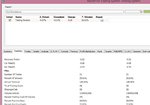Daddybyday
Junior member
- Messages
- 34
- Likes
- 5
Hello, All!
I've been on a lot today, journaling and bouncing ideas of y'all as I think about beginning to do more active trading in my retirement accounts. You can check out the scope of my project here: https://www.trade2win.com/threads/s...erm-etf-trading-strategy.234833/#post-3092379.
Here is another system that I've found in my wanderings that fascinates me. It is a pretty simple system based on the 50 and 100 SMA, and the MACD. You can read about it from the source here: https://www.investopedia.com/articles/forex/08/macd-combo.asp.
Here are the rules for a long trade, adjusted from a forex bias:
1) Wait for the currency to trade above both the 50 SMA and 100 SMA.
2) Once the price has broken above the closest SMA, enter long if MACD has crossed to positive within the last five bars, otherwise wait for the next MACD signal.
3) Set the initial stop at a five-bar low from the entry.
4) Exit half of the position at two times risk; move the stop to breakeven.
5) Exit the second half when the price breaks below the 50 SMA.
What I like about this:
1) I like the mechanical nature of it--entry and stops are clear, and it is pretty much a "set and forget" strategy.
2) I like that it looks like, on a daily chart, it will coincide well with the time frame that I'm looking to trade.
3) I like the dual aspect. In looking at chart strategies, there are 2 frustrations I find. One is that a strategy seems to pull you out too soon, leaving money on the table. The other is that it leaves you in too long, subjecting you to whipsaws, or giving back too much of your gains. I like the idea of locking in part of the profit by selling half of the position early, and letting the rest run.
What makes me nervous:
1) Again, the rigidity, does it really work?
2) This seems like it would be good for trending markets, but what about false breakouts during range-bound markets. How do I protect myself from that?
I'm going to pull up a chart from my universe, apply the indicators, and see what a past trade based on this strategy would look like, in the reply below.
As always, I'd truly appreciate your feedback, and experiences in using systems like this.
Thanks!
Tom
I've been on a lot today, journaling and bouncing ideas of y'all as I think about beginning to do more active trading in my retirement accounts. You can check out the scope of my project here: https://www.trade2win.com/threads/s...erm-etf-trading-strategy.234833/#post-3092379.
Here is another system that I've found in my wanderings that fascinates me. It is a pretty simple system based on the 50 and 100 SMA, and the MACD. You can read about it from the source here: https://www.investopedia.com/articles/forex/08/macd-combo.asp.
Here are the rules for a long trade, adjusted from a forex bias:
1) Wait for the currency to trade above both the 50 SMA and 100 SMA.
2) Once the price has broken above the closest SMA, enter long if MACD has crossed to positive within the last five bars, otherwise wait for the next MACD signal.
3) Set the initial stop at a five-bar low from the entry.
4) Exit half of the position at two times risk; move the stop to breakeven.
5) Exit the second half when the price breaks below the 50 SMA.
What I like about this:
1) I like the mechanical nature of it--entry and stops are clear, and it is pretty much a "set and forget" strategy.
2) I like that it looks like, on a daily chart, it will coincide well with the time frame that I'm looking to trade.
3) I like the dual aspect. In looking at chart strategies, there are 2 frustrations I find. One is that a strategy seems to pull you out too soon, leaving money on the table. The other is that it leaves you in too long, subjecting you to whipsaws, or giving back too much of your gains. I like the idea of locking in part of the profit by selling half of the position early, and letting the rest run.
What makes me nervous:
1) Again, the rigidity, does it really work?
2) This seems like it would be good for trending markets, but what about false breakouts during range-bound markets. How do I protect myself from that?
I'm going to pull up a chart from my universe, apply the indicators, and see what a past trade based on this strategy would look like, in the reply below.
As always, I'd truly appreciate your feedback, and experiences in using systems like this.
Thanks!
Tom

